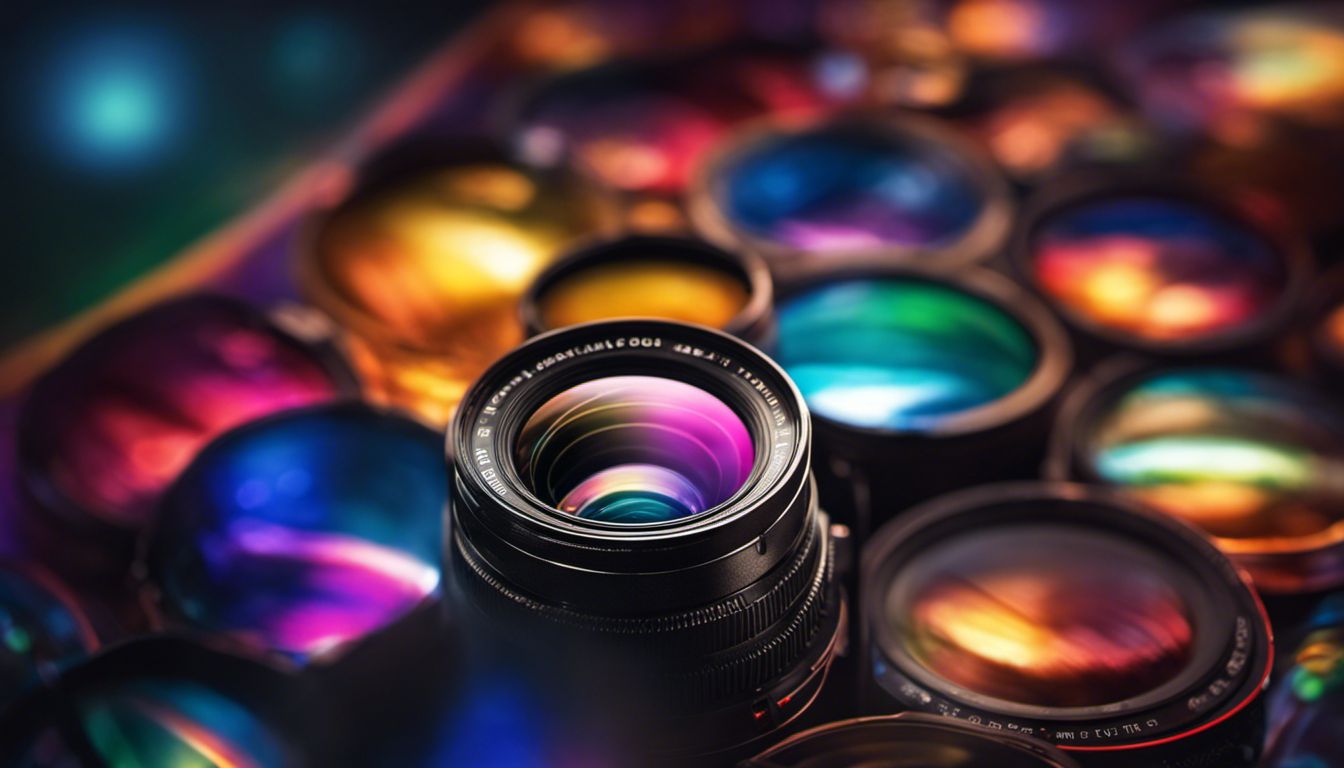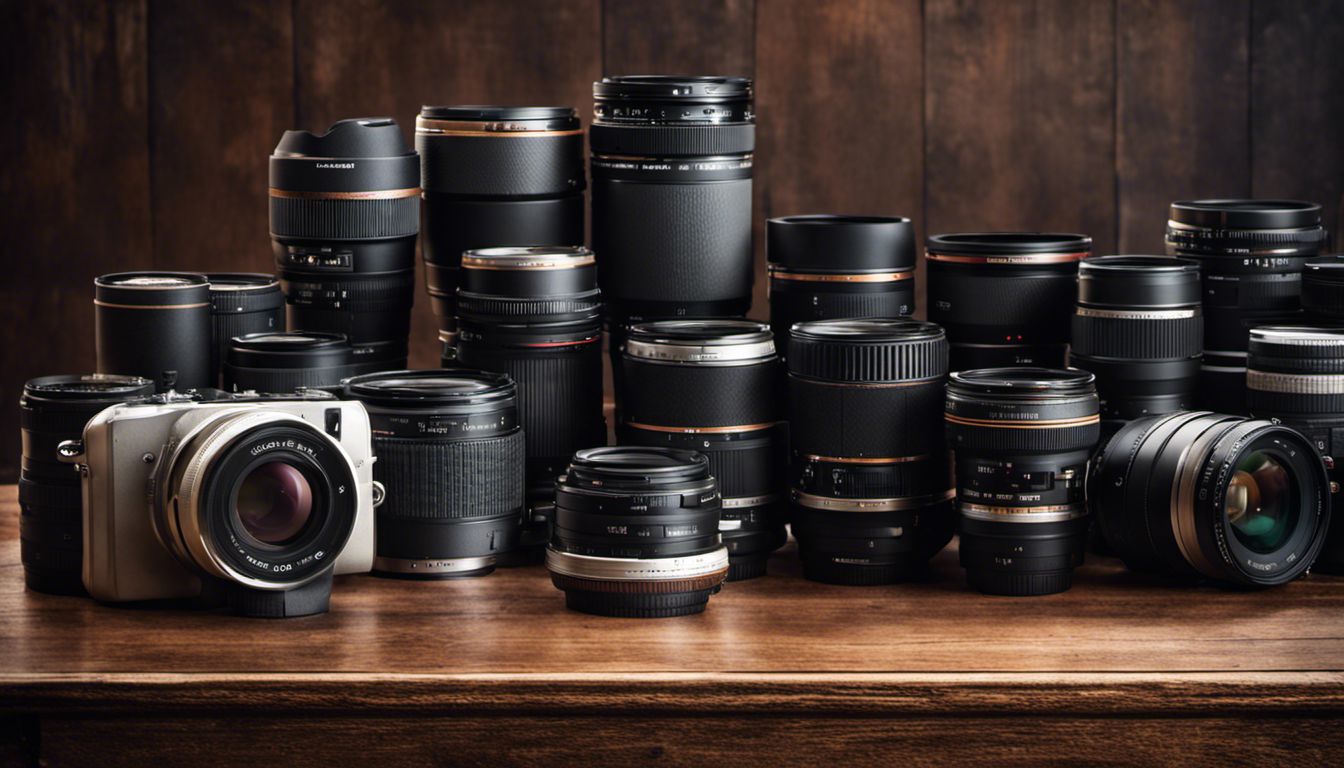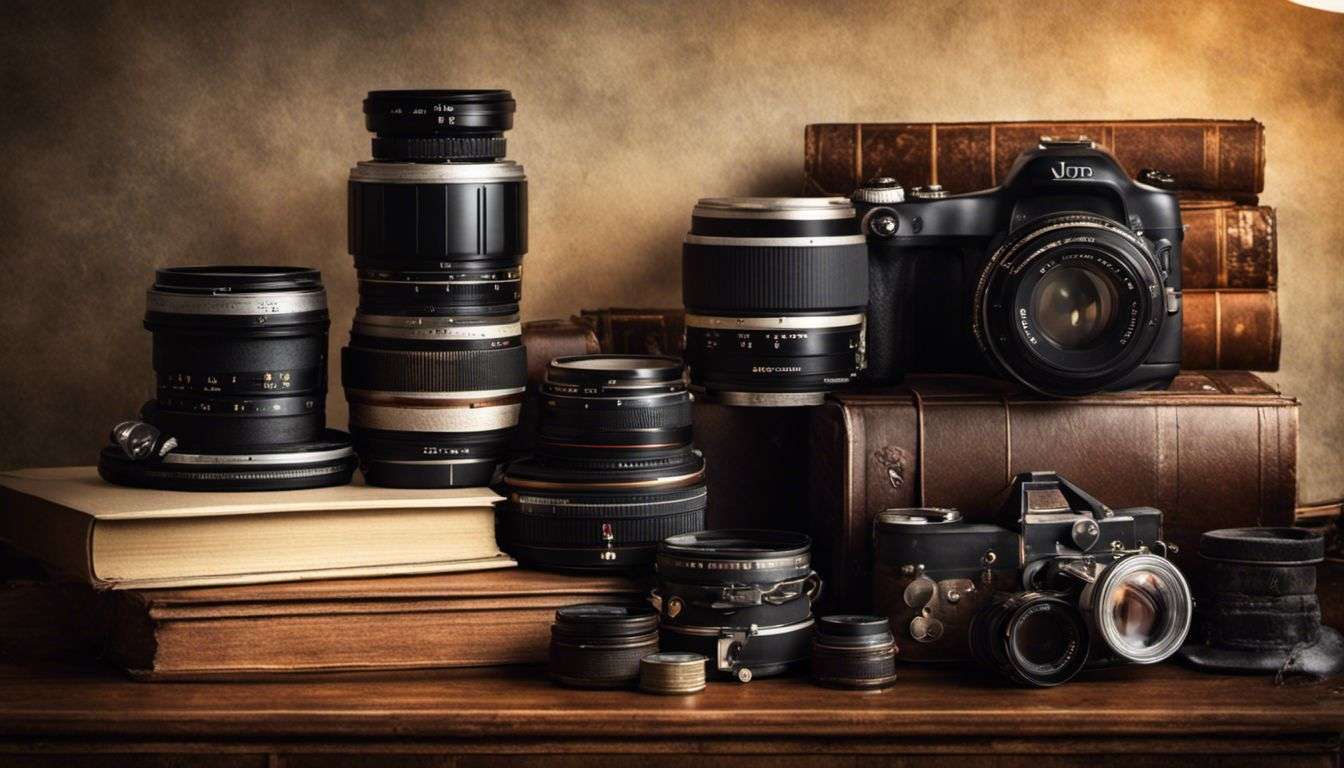If you’re embarking on your videography journey, choosing the right lens can be overwhelming. Did you know that the kind of lens you use can significantly alter your film’s look and feel? This comprehensive guide will demystify videography lenses, explaining everything from focal length to aperture, thus making an otherwise complex topic easily understandable.
Ready for a deep-dive into selecting the perfect lens for high-quality videos? Let’s get started!
Key Takeaways
- Videography lenses are crucial for capturing high – quality videos and have a significant impact on the look and feel of your footage.
- Understanding concepts like focal length and aperture helps you select the right lens for different shooting scenarios, such as wide-angle lenses for expansive scenes or telephoto lenses for capturing distant subjects.
- Prime lenses offer sharper images and wider apertures, while zoom lenses provide versatility by allowing you to adjust the focal length without changing position.
- Consider features like image stabilization, parfocal capability, electronic or mechanical focusing, and how the sensor size affects focal length when choosing videography lenses.
Understanding Camera Lenses

A lens is a crucial component for videography, allowing you to capture clear and high-quality videos.
What is a lens and why do you need one?
A lens is a crucial component of your camera that captures light and influences how your image appears. Different types of lenses can produce varying field views, depths, and levels of brightness in photos or videos.
You need a lens because it magnifies the scene before you and focuses the incoming light onto the sensor to form an image. It’s not just about capturing images; different lenses can change perspectives, alter lighting conditions, highlight details, or add special effects like blurring backgrounds for more professional results in film making or photography.
Focal length
Focal length, measured in millimeters (mm), plays a crucial role in defining the field of view for videography lenses. In simplified terms, it determines how ‘zoomed in’ your photos appear and can dramatically affect your output’s overall look.
A smaller focal length gives you a wider field of view, while a larger one narrows it down.
In cinematography lenses like prime and zoom ones, the concept holds significant value. It directly influences depth perception and perspective distortion. For instance, wide-angle lenses usually have short focal lengths between 16-35mm and provide expansive views perfect for landscapes or large group shots.
On the other hand, telephoto lenses with long focal lengths over 70mm are great for close-ups or capturing far-off details with selective focus effects.
Aperture
Aperture is a critical factor in videography lenses that balances the amount of light transmission. In simpler terms, it works similar to our eyes’ pupil; as it dilates in low light conditions and contracts when there’s too much sunlight.
The aperture measure often appears as f/number like f/1.4, f/2, and so on – referred to as ‘f-stops’. Lower numbers mean higher apertures which allow more light into the camera lens for brighter footage, especially beneficial for darker scenes or indoor videography.
On the other hand, high ‘f-stop’ numbers indicate smaller apertures best suited for outdoor shoots with ample lighting where they limit excessive brightness collected by your film lenses.
Notably, different cinematographic looks can be achieved by creatively adjusting these settings which directly impacts video quality captured through DSLR lenses or mirrorless camera lenses.
Understanding how to manipulate aperture gives filmmakers control over their work’s visual aspects – including depth of field (how much of your shot is kept in focus) and exposure (the total amount of light hitting your digital sensor).
This makes it an essential consideration while selecting appropriate cinematic camera lenses from choices that include prime and zoom variants.
Prime lenses vs zoom lenses
Prime lenses and zoom lenses each have their unique features and applications in videography. Understanding their differences can help you choose the right lens for your specific needs.
| Features | Prime Lenses | Zoom Lenses |
|---|---|---|
| Focal Length | Prime lenses have a fixed focal length. This means you have to move closer or farther from your subject to change the frame. | Zoom lenses offer variable focal lengths. You can easily adjust your frame by zooming in or out without moving your position. |
| Image Quality | Prime lenses generally offer higher image quality. They have fewer moving parts which can result in sharper, clearer images. | Zoom lenses offer flexibility but may compromise on image quality. The complex construction can sometimes cause distortion or softness in the image. |
| Aperture | Prime lenses often have wider maximum apertures. This can allow for better performance in low light conditions and shallower depth of field. | Zoom lenses typically have smaller maximum apertures. While some high-end zoom lenses can match the aperture of prime lenses, they are generally more expensive. |
| Price | Prime lenses are usually more affordable than zoom lenses. | Zoom lenses are typically more expensive due to their versatility and complex construction. |
| Size and Weight | Prime lenses are typically lighter and more compact, making them ideal for handheld shooting. | Zoom lenses are usually heavier and bulkier due to their larger elements and more complex construction. |
Types of Camera Lenses

Discover the different types of camera lenses, from standard to extreme, and learn which lens is best suited for your videography needs.
Standard lenses
Standard lenses, also known as normal lenses, are the go-to choice for many videographers and photographers. These lenses offer a field of view that closely resembles what the human eye sees, making them versatile for different types of shots.
Usually with a focal length between 35mm to 50mm, standard lenses deliver images with minimal distortion and are great for capturing everyday scenes or portraits in a natural-looking way.
They excel at producing sharp details and accurate colors, ensuring high-quality visuals in your videos. Standard lenses are often included as kit lenses when purchasing cameras, providing an excellent starting point for those new to videography or photography.
Wide-angle lenses
Wide-angle lenses are essential tools for videographers looking to capture expansive scenes or subjects in close proximity. These lenses have a shorter focal length, typically below 35mm, allowing them to capture a wide field of view.
They excel at creating depth and emphasizing the foreground while still capturing the surrounding environment. With their ability to exaggerate perspective, wide-angle lenses add a unique dynamic to videos and can make spaces appear larger than they actually are.
Whether you’re shooting landscapes, architecture, or even action sequences, wide-angle lenses offer an immersive viewing experience that brings your audience into the heart of the action.
Long focus lenses
Long focus lenses, also known as telephoto lenses, are essential tools in videography. These lenses have a longer focal length, allowing you to capture distant subjects with incredible clarity and detail.
Perfect for shooting sports events or wildlife documentaries, long focus lenses bring faraway subjects closer and create stunning visuals. With their narrow field of view, they also help to isolate the subject from the background, giving your videos a professional and cinematic look.
Whether you’re capturing action-packed moments or mesmerizing landscapes, long focus lenses are a must-have for any videographer looking to take their footage to the next level.
Extreme lenses
Extreme lenses are designed for specific situations where you need to achieve unique and exaggerated effects. These lenses offer extreme focal lengths or wide apertures, allowing you to capture breathtaking images with a distinctive look.
For example, fisheye lenses provide an extremely wide angle of view, resulting in a spherical or distorted image. On the other hand, tilt-shift lenses allow you to manipulate perspective and control depth of field for creative effects.
Extreme lenses may not be necessary for every videographer, but they can add an extra level of creativity and visual impact to your videos when used strategically.
Deep Dive into Understanding Videography Lenses
Videography lenses play a crucial role in capturing high-quality videos and achieving that coveted cinematic look. They come in various types, including prime lenses and zoom lenses, each offering unique advantages.
Prime lenses have a fixed focal length, which means they can’t zoom in or out but often provide sharper images and wider apertures for better low-light performance. On the other hand, zoom lenses offer versatility by allowing you to adjust the focal length without changing your position, making them ideal for situations where quick changes are necessary.
It’s important to understand these differences and consider factors such as lens speed, image stabilization, parfocal capability, focus breathing, and how the sensor size affects the focal length when choosing videography lenses for film production or video projects.
Important Features to Consider
Consider features such as image stabilization, electronic or mechanical focusing, parfocal lenses, focus breathing, and how focal length affects the image for high-quality videos. Read on to learn more!
Image stabilization
Image stabilization is a crucial feature to consider when choosing videography lenses. It helps to reduce camera shake and produce smoother, more stable footage. With image stabilization, you can capture steady shots even when shooting handheld or in low-light conditions.
This feature compensates for any unintentional movement of the camera and ensures that your videos appear professional and polished.
Electronic or mechanical focusing
Electronic or mechanical focusing is an important feature to consider when choosing videography lenses. This refers to how the lens focuses on subjects in a video. Electronic focusing uses motors and sensors to automatically adjust the focus, allowing for faster and more accurate focusing.
On the other hand, mechanical focusing requires manual adjustment of the focus ring on the lens itself. Both options have their advantages, with electronic focusing being more convenient for quick changes in focus during filming, while some filmmakers prefer the precise control offered by mechanical focusing.
The choice between electronic or mechanical focusing ultimately depends on personal preference and shooting style.
Parfocal lenses
Parfocal lenses are a key feature to consider when selecting videography lenses. These lenses maintain focus on the subject even when zooming in or out, which is particularly important for video production.
With parfocal lenses, you can smoothly adjust your shot without losing focus, resulting in professional-looking videos with crisp and clear images. This feature saves time and effort during filmmaking as there is no need to constantly readjust the focus after zooming.
Whether you’re shooting fast-paced action scenes or capturing close-up details, parfocal lenses are an essential tool for achieving high-quality videos with consistent focus throughout the entire shot.
Focus breathing
Focus breathing is a common phenomenon in videography lenses where the image changes size or composition as you adjust the focus. This can be problematic when shooting videos because it can affect the overall quality and stability of your footage.
For example, when focusing on a subject, the background might appear to expand or contract, which could distract viewers from the main subject. It’s important to consider this aspect when choosing lenses for videography to ensure smooth and consistent focusing throughout your shots.
Focal length and sensor size
The focal length and sensor size of a camera lens are two important factors that greatly impact the images or videos you capture. Focal length determines the field of view and magnification of the lens, with shorter focal lengths offering wider angles and longer focal lengths providing more zoom.
Sensor size, on the other hand, affects how much light is captured by the camera and impacts image quality. A larger sensor can produce better low-light performance and shallower depth of field.
Understanding these two aspects will help you choose lenses that suit your needs and achieve desired results in your videography endeavors.
Choosing the Best Lenses for Filmmaking
Learn how to choose the perfect lenses for your filmmaking needs and take your videos to the next level.
Prime vs zoom lenses
Prime and zoom lenses both have their unique advantages and challenges in filmmaking. The table below provides a comparison to help you better understand their differences and how they can impact your videography work.
| Features | Prime Lenses | Zoom Lenses |
|---|---|---|
| Focal Length | Prime lenses have a fixed focal length. | Zoom lenses offer a range of focal lengths. |
| Image Quality | Prime lenses generally deliver sharper images. | Image quality in zoom lenses may vary across different focal lengths. |
| Aperture | Prime lenses usually have wider apertures, allowing more light intake. | Aperture in zoom lenses can be variable, limiting light intake at certain focal lengths. |
| Size and Weight | Prime lenses are typically lighter and more compact. | Zoom lenses tend to be heavier and bulkier. |
| Flexibility | Prime lenses require changing lenses to adjust the field of view. | Zoom lenses allow adjusting the field of view without changing the lens. |
Remember, the best lens for you depends on your specific filmmaking needs and style. Consider these factors when deciding between prime and zoom lenses.
Lens speed and other considerations
Lens speed is an important factor to consider when choosing a videography lens. The speed of a lens refers to its maximum aperture, which determines how much light it can let in. A faster lens with a larger maximum aperture allows more light into the camera, which is crucial for shooting in low-light conditions or achieving shallow depth of field effects.
Another consideration is the autofocus system, as some lenses have faster and more accurate focusing capabilities than others. Lastly, you may want to think about the size and weight of the lens, especially if you plan on doing handheld or run-and-gun style filming.
These factors will help you select the right lens for your specific videography needs.
Understanding camera lenses
Camera lenses are an essential part of capturing high-quality videos and creating that cinematic look. They play a crucial role in determining the focal length, aperture, and overall quality of your images.
There are two main types of camera lenses: prime lenses and zoom lenses. Prime lenses have a fixed focal length, which means they offer excellent image quality but limited flexibility in terms of zooming.
On the other hand, zoom lenses provide a range of focal lengths, allowing you to easily adjust the magnification without changing the lens. Understanding these differences will help you choose the right lens for your filmmaking needs.
How focal length affects the image
The focal length of a camera lens has a significant impact on the image you capture. A shorter focal length, such as a wide-angle lens, allows you to fit more into the frame and creates a sense of depth.
On the other hand, a longer focal length, like a telephoto lens, magnifies distant objects and compresses the perspective. Understanding how different focal lengths affect your image will help you choose the right lens for your desired shot.
Tips for shooting with prime lenses
- Use prime lenses to achieve a more cinematic look.
- Experiment with different focal lengths to capture various perspectives and depth of field.
- Take advantage of the wide aperture of prime lenses for low – light situations and shallow depth of field.
- Plan your shots carefully as prime lenses have a fixed focal length, requiring you to physically move closer or farther from your subject.
- Pay attention to composition and framing to make the most out of the limited focal range of prime lenses.
- Familiarize yourself with the specific characteristics and quirks of each prime lens in your kit.
- Practice manual focusing techniques for precise control over your shots.
- Consider using lens filters to enhance your visuals or add creative effects.
- Invest in high – quality prime lenses for better image sharpness and overall video quality.
- Keep practicing and experimenting with different shooting techniques to improve your skills with prime lenses.
Conclusion
In conclusion, understanding videography lenses is essential for capturing high-quality videos. By grasping concepts such as focal length, aperture, and the differences between prime and zoom lenses, filmmakers can achieve the cinematic look they desire.
Considering important features like image stabilization and focus breathing further enhances the quality of their footage. Armed with this comprehensive guide, filmmakers are empowered to make informed decisions when selecting camera lenses for their video production needs.
What Video Editing Software is Best Suited for Different Types of Videography Lenses?
When it comes to videography lenses, it’s essential to choose video editing software that caters to their specific needs. For wide-angle lenses, programs with distortion correction features are crucial to ensure straight lines. Telephoto lenses, on the other hand, benefit from software that offers stabilization options to minimize shaky footage. Tilt-shift lenses are best paired with editing software that allows for selective blur effects and perspective manipulation. Ultimately, the ideal video editing software choice depends on the type of lens used and the desired outcome of the footage.
What Are Some Common Uses of Videography Lenses?
Videography lenses and their practical applications vary widely depending on the desired outcome. Wide-angle lenses are commonly used for landscape shots or capturing large areas. Telephoto lenses allow for close-ups from a distance, ideal for wildlife or sports events. Prime lenses offer superior image quality, while zoom lenses provide flexibility and versatility. Macro lenses enable detailed close-ups of small subjects, while fisheye lenses create unique distorted perspectives. Each lens serves a specific purpose, enhancing videographers’ ability to capture diverse scenes.
FAQs
1. What is a videography lens?
A videography lens is a camera lens specifically designed for capturing high-quality video footage, with features that enhance focus, depth of field, and image clarity.
2. How do I choose the right videography lens for my needs?
To choose the right videography lens, consider factors such as focal length, aperture size, image stabilization, and compatibility with your camera model. Researching different lens options and experimenting with them can help you find the best fit for your specific requirements.
3. Can I use photography lenses for videography purposes?
Yes, you can use some photography lenses for videography purposes; however, not all photography lenses are optimized for video recording. It’s important to consider factors like autofocus speed and smoothness when selecting a lens specifically for shooting videos.
4. How does the choice of lens affect my video footage?
The choice of lens plays a significant role in determining various aspects of your video footage such as field of view (wide-angle vs telephoto), depth of field (shallow vs deep), and overall visual aesthetics. Different lenses can create different cinematic effects or capture scenes from unique perspectives.
5. Are prime lenses or zoom lenses better for videography?
Both prime lenses (fixed focal length) and zoom lenses have their advantages in videography. Prime lenses tend to offer wider apertures and sharper image quality but require physically moving closer or further from the subject to adjust framing. Zoom lenses provide flexibility by offering variable focal lengths without changing positions but may have narrower maximum apertures compared to primes.






